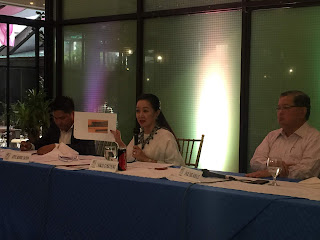 The Department of Trade and Industry (DTI) under the honorable Secretary Ramon Lopez was briefed on the importance and the critical implications of the Philippine steel manufacturers’ substitution of micro alloy (MA) reinforced bars with quenched tempered (QT/TMT) steel rebars for over 10 years ago.
The Department of Trade and Industry (DTI) under the honorable Secretary Ramon Lopez was briefed on the importance and the critical implications of the Philippine steel manufacturers’ substitution of micro alloy (MA) reinforced bars with quenched tempered (QT/TMT) steel rebars for over 10 years ago.
Last Friday, May 11 2018, Secretary Lopez presided over a forum of stakeholders at the BOI AVR in Makati where Engineer Emilio Morales presented again before the construction industry and leaders of various government agencies the study “A CLEAR AND PRESENT DANGER - THE USE OF QT OR TMT REBARS IN SEISMIC ZONE 4” which he published about 8 Years ago, and presented in various Structural Engineer’s Fora at the National and Regional levels.
The steel industry representative, Mr. Wellington Tong, of PAGASA Steel, discussed the QT production process and has not addressed issues raised by Engineer Morales which was the purpose of the DTI Forum, who has been warning the public on the use of QT/TMT for high rise buildings as these bars have a brittle outer layer and a weaker inner core after welding, threading, bending and galvanizing. These bars are also shown to have easily failed in cyclic loading tests.
Senator Nikki Coseteng, on her part, also asked critical questions that were not answered at all by the steel industry representatives as has been their predilection for over 10 years.
All sides were represented yet questions remained unanswered and critical issues not directly addressed pertaining to the Uninformed use of QT/TMT rebars.
“I was expecting clear and categorical answers as the owner of PAGASA Steel was present. But nothing has been said that could clear up the matter.
Did steel factories replace MA with QT? How long ago? Were the engineering community, government agencies, developers, contractors, and end users formally and officially informed? If so, how?”
She also asked the following questions.
“1. Are the Grade 60 steel bars manufactured truly Grade 60 and would behave as a homogeneous rebar even under earthquake loading?
2. Can they show test results periodically conducted in the last 10 years showing these steel bars can be welded, threaded, galvanized, bended and heated? How will it behave in an earthquake loading especially in Seismic Zone 4 such as the Philippines?”
The ASEP supported the Morales study by inclusion of the Prohibitions on the use of QT/TMT Rebars in Seismic Zone 4 in the National Structural Code for Buildings 2015.
However, the recent position Paper of the ASEP Board, although maintaining that the use of QT/TMT bars is subject to and consistent with the Code prohibitions, have stated that QT/TMT bars “ can be used for all buildings including High rises” Which contradicts the prohibitions of the NSCP 2015 and deserves clarification from the ASEP Board. Otherwise, there will be confusion because of the seemingly contradictory positions within the same Position paper.
Senator Coseteng asked if they could show new tests to prove the Morales study facts wrong. ASEP claimed that their stand is consistent with the Code Prohibitions but failed to explain the contradictory position within the ASEP Position Paper as called out in the forum by Engineer Morales.
Other questions that have remained unanswered were:
“Why is the grade of steel only determined by color coding instead of embossing the grade with the name of the steel company and size of the bar?
Discussions in the TC 11 have been ongoing for a long time yet it seems like public safety and information have taken 2nd priority under the interests of the steel manufacturers because critical actions voiced by other members outside the steel industry have not been acted upon.
Why is the entire country still in the dark?

No comments:
Post a Comment